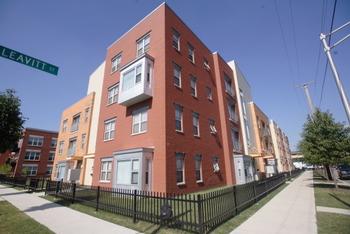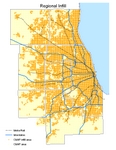Infill Scenario Outcome
Infill housing built in an older community

"Infill development" refers to growth that occurs in existing communities that already have infrastructure available, rather than undeveloped areas. Infill development can revitalize economically disadvantaged communities, reduce the cost of providing additional infrastructure to support new growth, and preserve natural resources in undeveloped areas.
How would this scenario change from the reference? |
|
|
Reinvest |
Improves |
|
Preserve |
Improves slightly |
|
Innovate |
Stays the same |
Change in growth in infill areas |
|
|
Reinvest |
+18% (95,000 more households) |
|
Preserve |
+8% (43,000 more households) |
|
Innovate |
No change |
What strategies in this scenario caused this change? |
|
|
Reinvest |
Transportation improvements, a major emphasis on transit oriented development (TOD), and brownfield remediation spurred growth in existing communities. An aggressive farmland preservation program also prevented development on the region's prime farmland. |
|
Preserve |
Improvements to the transit, bicycle, and pedestrian systems, as well as a modest implementation of transit oriented development (TOD) attracted more people to already developed communities. Open space preservation and a moderate amount of farmland preservation also prevented development in some undeveloped areas. |
|
Innovate |
This scenario did not change the location of growth compared to the reference. |
 For this analysis, development that occurred within current municipal boundaries was considered to be "infill." Because the scale of analysis is regional, the location of municipal boundaries is approximate, and some land immediately outside municipal boundaries is included in the definition of infill. Approximately 90% of the region's residents currently live within the areas highlighted in this map.
For this analysis, development that occurred within current municipal boundaries was considered to be "infill." Because the scale of analysis is regional, the location of municipal boundaries is approximate, and some land immediately outside municipal boundaries is included in the definition of infill. Approximately 90% of the region's residents currently live within the areas highlighted in this map.
Between now and 2040, the region will grow by about 790,000 households. If current trends continue, approximately 67% of this growth (530,000 households) will occur in infill areas. This number is fairly high because the definition of infill used in this analysis is quite broad and includes all development within current municipal boundaries (even on land that is currently undeveloped) as well as some development immediately nearby existing municipalities.
The impacts of each scenario on infill development are described below, estimating the number of additional households that will locate in infill areas compared to the current trend (with an increase considered to be an improvement). The base figure is 530,000 households.
These estimates were calculated by applying the definition of infill noted above to the forecasts for each scenario. A summary of the difference between scenario forecasts which breaks the region into "density districts" is available here. More complex methods for defining infill potential are described in the Infill Snapshot report, which analyzes the potential for infill development around the region using Improvement-to-Land Value ratios.